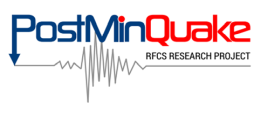NEW MINING INSTRUMENTAL SEISMICITY SCALE – MSIIS-22 UPDATED FOR POST- MINING SEISMICITY
As a part of the research work in the RFCS, PostMinQuake project, a new version of the instrumental scale of the intensity and harmfulness of mining and post-mining tremors (MSIIS-22) for buildings was developed at Central Mining Institute (Department of Geology, Geophysics and Surface Protection). To develop the scale, the data set on mining tremors collected in the areas of selected mines, being in the process of flooding in Poland, France, Germany and the Czech Republic were used. These data indicate that the majority of recorded post-mining tremors are characterized by small values of the maximum amplitude of vibration velocity (PGV) of near-surface soils (<1mm/s). For these, low energy tremors (M<1), an additional degree I was introduced in the hitherto existing scale of intensity of mining tremors MSIIS. As the seismological literature on post-mining seismicity from outside Europe (South Africa) reports cases of high-energy and magnitude quakes recorded in post-mining areas, degree VIII was added to the existing scale. Such tremors can induce short (duration <1.5 s) and longer (duration > 1.5s) vibrations of the near-surface soils, characterized by PGV values respectively exceeding 160 mm/s and 100 mm/s.
The Mining Seismic Instrumental Intensity Scale MSIIS-22 is applied to assess the impact of vibrations caused by seismic events induced by mining and post-mining tremors on buildings, linear objects of the underground infrastructure and the perceptibility of vibrations by humans. The short form of the MSIIS-22 scale is intended to give a very generalized view of the scale and is presented in Table 1 and Table 2.

The effects of vibration harmfulness expressed with the degree of harmfulness S, assigned to the instrumental measurement levels of the IMSIIS seismic intensity, are different for different building structures and their technical condition (Table 2).
The following types of buildings were distinguished in the observations:
Type of structures:
Masonry buildings (I)
- simple stone masonry (I-A)
- unreinforced brick masonry (I-B)
- unreinforced brick masonry with RC floor (I-C)
- reinforced masonry (I-D)
Reinforced concrete wall structures buildings (II)
Reinforced concrete frame buildings (III)


